

Betty Bowers Explains Traditional Marriage to Everyone Else. Shamhat and Enkidu. …So the trapper set out on his journey to Uruk and adressed himself to Gilgamesh saying, ’A man unlike any other is roaming now in the pastures; he is as strong as a star from heaven and I am afraid to approach him.
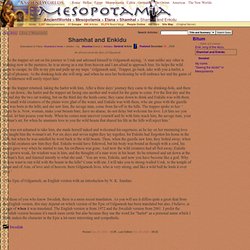
He helps the wild game to escape; he fills in my pits and pulls up my traps.’ Gilgamesh said, ‘Trapper, go back, take with you a harlot, a child of pleasure. At the drinking-hole she will strip, and when he sees her beckoning he will embrace her and the game of the wilderness will surely reject him.’ Now the trapper returned, taking the harlot with him. After a three days’ journey they came to the drinking-hole, and there they sat down.; the harlot and the trapper sat facing one another and waited for the game to come. She was not ashamed to take him, she made herself naked and welcomed his eagerness; as he lay on her mumuring love she taught him the woman’s art.
. - The Epic of Gilgamesh, an English version with an introduction by N. Shamhat. Enkidu. Enkidu (𒂗𒆠𒆕 EN.KI.DU3 "Enki's creation") is a central figure in the Ancient Mesopotamian Epic of Gilgamesh.
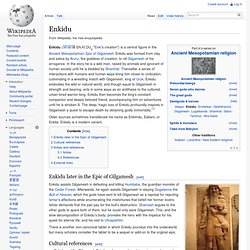
Enkidu was formed from clay and saliva by Aruru, the goddess of creation, to rid Gilgamesh of his arrogance. In the story he is a wild man, raised by animals and ignorant of human society until he is bedded by Shamhat. Thereafter a series of interactions with humans and human ways bring him closer to civilization, culminating in a wrestling match with Gilgamesh, king of Uruk. Enkidu embodies the wild or natural world, and though equal to Gilgamesh in strength and bearing, acts in some ways as an antithesis to the cultured, urban-bred warrior-king. Enkidu then becomes the king's constant companion and deeply beloved friend, accompanying him on adventures until he is stricken ill.
Older sources sometimes transliterate his name as Enkimdu, Eabani, or Enkita. The Orgins of Adam and the Garden of Eden. I previously traced, to my own satisfaction, the real sources of modern day belief in angles, sin, Eve and the rib, Noah’s ark and the holy spirit.
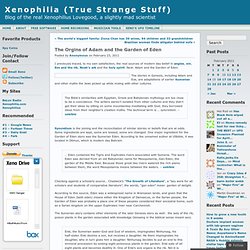
Next: Adam and the Garden of Eden. The stories in Genesis, including Adam and Eve, are adaptations of earlier Sumerian and other myths the Jews picked up while mixing with other cultures. The Bible’s similarities with Egyptian, Greek and Babylonian mythology are too close to be a coincidence. The writers weren’t isolated from other cultures and they didn’t get their ideas by sitting on some mountaintop meditating with God; they borrowed ideas from their neighbor’s creation myths. The technical term is … syncretism. – usbible Syncretism is the joining and the reconciliation of similar stories or beliefs that are at odds. .
… Eden contained the Tigris and Euphrates rivers associated with Sumeria. Eve and the Identity of Women: 7. Eve & Lilith. In an effort to explain inconsistencies in the Old Testament, there developed in Jewish literature a complex interpretive system called the midrash which attempts to reconcile biblical contradictions and bring new meaning to the scriptural text.
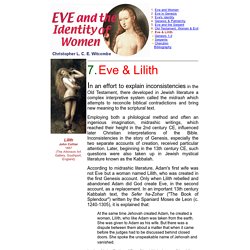
Employing both a philological method and often an ingenious imagination, midrashic writings, which reached their height in the 2nd century CE, influenced later Christian interpretations of the Bible. The Lilith Myth. Lilith. Lilith (Hebrew: לילית; lilit, or lilith) is a Hebrew name for a figure in Jewish mythology, developed earliest in the Babylonian Talmud, who is generally thought to be in part derived from a class of female demons Līlīṯu in Mesopotamian texts of Assyria and Babylonia.
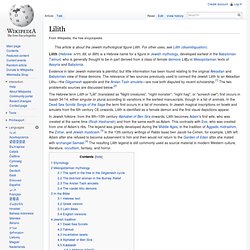
Evidence in later Jewish materials is plentiful, but little information has been found relating to the original Akkadian and Babylonian view of these demons. The relevance of two sources previously used to connect the Jewish Lilith to an Akkadian Lilitu—the Gilgamesh appendix and the Arslan Tash amulets—are now both disputed by recent scholarship.[1] The two problematic sources are discussed below.[2] The Hebrew term Lilith or "Lilit" (translated as "Night creatures", "night monster", "night hag", or "screech owl") first occurs in Isaiah 34:14, either singular or plural according to variations in the earliest manuscripts, though in a list of animals. Etymology[edit] In Akkadian the terms lili and līlītu mean spirits.
[edit] Creation myth. Creation myths develop in oral traditions and therefore typically have multiple versions[3] and are the most common form of myth, found throughout human culture.[6] Definitions[edit] In Daoist creation myth, "The Way gave birth to unity; unity gave birth to duality; duality gave birth to trinity; trinity gave birth to the myriad creatures.
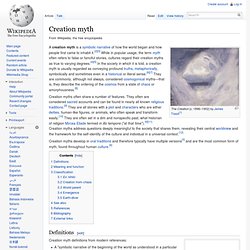
" (Daodejing, 4th century BCE)[13] Creation myth definitions from modern references: A "symbolic narrative of the beginning of the world as understood in a particular tradition and community. Religion professor Mircea Eliade defined the word myth in terms of creation: Myth narrates a sacred history; it relates an event that took place in primordial Time, the fabled time of the "beginnings. "